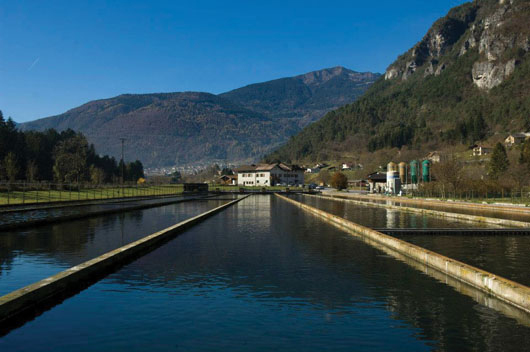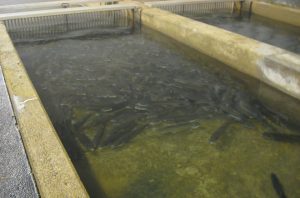Through GAIN project, funded by EU Horizon 2020 Fund, Italian trout facility fine-tunes oxygen supply on the basis of forecasted demand

This article continues our series on precision aquaculture (insert links to introduction and first article), part of a larger three-part series on sustainable aquaculture intensification in Europe, focused on precision aquaculture, sustainable feeds, and circular economy. This work from the GAIN project is funded by the EU Horizon 2020 Fund. Each part in this series takes provides an introductory glance at the three topics, then explains how outputs from the GAIN project are contributing towards it, including the applicability to industry and governance. (Also see Part 1: data and evidence-based management; and Part 2: Precision sea bass.)
Like many species, rainbow trout cultured in raceways rely on supplementary oxygen for optimal welfare and production. While many farms simply supplement tanks with oxygen continuously, this can lead to overuse of resources and increased costs. To implement precision aquaculture for customized and optimal oxygen supplementation, aquaculture researchers have collaborated with an unlikely sector: space engineering.
Researchers at Ca’Foscari University have partnered with Troticoltura Leonardi, a family-run rainbow trout farm in northern Italy to implement precision aquaculture, aiming to improve the decision support of farm managers by taking advantage of low-cost sensors, mathematical models of biological processes and data processing methods to optimize the use of oxygen in tanks.
This research was led by Roberto Pastres, who has experience in modelling activities in aquaculture and oceanography, and Edouard Royer, a space engineer who applies data processing methods to the aquaculture sector. This team applied the Kalman Filter data-assimilation method that was first used in the Apollo space program to optimize oxygen supply and bring the benefits of precision aquaculture to the Troticoltura Leonardi farm.
Their dissolved oxygen model and space-inspired data assimilation method used environmental measures (dissolved oxygen and temperature) and non-invasive fish monitoring measures (average fish weight). They demonstrated that their methods reliably forecasted the oxygen demands of fish, computing hourly oxygen requirements for each raceway.

This allowed the farm technicians to fine-tune oxygen supply on the basis of forecasted demand instead of providing a constant supply, leading to a smart and efficient use of oxygen. Optimizing oxygen has led to better fish welfare by ensuring optimum conditions in the raceway, increased economic margins through better use of oxygen and energy resources; and environmental sustainability by improving water quality in effluent.
Their colleague Silvio Cristiano conducted a Life-Cycle Assessment (LCA) using data collected through precision aquaculture at the trout farm. LCA are environmental assessments of farms, where all resources and impacts for the entire life-cycle of the product are considered. LCAs are popular among sustainability researchers as they measure parameters like carbon emissions, energy use, and eutrophication. Cristiano compared LCAs from before and after the oxygen optimization methods were implemented, and confirmed a reduction in environmental impact with the new system, while providing hints for further improvements.
These methods have successfully been trialed and researchers are now working closely with engineers to scale the solution. Importantly, their models and methods are easily adaptable and transferrable for use with other cultured fish species that rely on supplementary oxygen.
This project has received funding from the European Union’s Horizon 2020 research and innovation program under grant agreement N° 773330.
Now that you've reached the end of the article ...
… please consider supporting GSA’s mission to advance responsible seafood practices through education, advocacy and third-party assurances. The Advocate aims to document the evolution of responsible seafood practices and share the expansive knowledge of our vast network of contributors.
By becoming a Global Seafood Alliance member, you’re ensuring that all of the pre-competitive work we do through member benefits, resources and events can continue. Individual membership costs just $50 a year.
Not a GSA member? Join us.
Authors
-
Roberto Pastres
Professor of Ecology, Università Ca' Foscari Venezia
-
Edouard Royer
Senior Engineer in Aerospace and Software, Università Ca' Foscari Venezia
-
Silvio Cristiano
Post-doctorate in Environmental Science, Informatics, and Statistics, Università Ca' Foscari Venezia
-
Alexandra Pounds
Assistant Researcher in Aquatic Food Security, Institute of Aquaculture, University of Stirling


